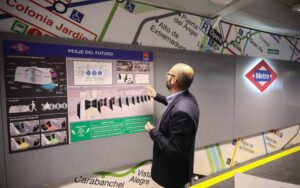Metro de Madrid advances in its digitization process
The digital transformation of the metro in the Spanish capital includes station 4.0 and the digital train as main axes
Metro de Madrid is currently working on a digital transformation plan with which it seeks to adapt its offer to demand in a more agile way and for which it has proposed new features such as station 4.0, in which the user is connected in real time to the facilities, and the digital train, as the company explained in the virtual colloquium organized by the enerTIC.org Platform.
The entity has explained Metro’s technological priorities centered on a series of strategic objectives: public service, efficiency and customer experience; adaptation of supply to demand and greater agility; boosting security; efficiency and sustainability and technological evolution and digitization, as explained by the CEO of Metro de Madrid, Silvia Roldán.
Today Metro, in addition to serving Madrid capital, reaches 12 municipalities, has more than 7,000 employees, has 302 stations, 294 kilometers of network and transports 2.2 to 2.4 million passengers daily. It represents 40 percent of the entire movement of public transport in the Community of Madrid.
Smart Rail: Station 4.0 and digital train

Currently, one of the pillars of Metro de Madrid’s digital transformation is the concept of ‘Smart Rail’, with two main axes: the 4.0 station and the digital train.
Station 4.0 will allow users to be connected in real time with all facilities, which will help to work with predictive maintenance. Something that will complement the digital train, achieving between both projects greater reliability, more energy efficiency, maintenance according to condition and 100 % orientation to the traveler.
Metro de Madrid’s digital transformation also encompasses other key lines: energy efficiency and sustainability; cybersecurity, from a strategic, tactical and operational perspective; data governance, with information exploitation systems through a collaborative environment; open and scalable systems for rapid adaptation and evolution of technologies; culture of transversal innovation of the organization; and the focus on current and future clients.
Energy reduction of up to 80% in lighting
Another axis of the company’s work for the future is the commitment to energy efficiency and sustainability. “We contribute to the SDGs with the reduction of pollution, the well-being of employees and customers, energy efficiency, job stability and the creation of indirect employment, as well as with environmental protection“, comments the CEO of Metro.
The company has achieved a 25 percent reduction in energy consumption with an energy saving plan, a 14 percent decrease in water consumption, an increase in the use of recycled water by 60 percent and a 28 percent reduction in waste compared to 2018.
In addition, there are different actions in the energy plan, including the improvement of lighting in the stations by replacing the luminaires with LEDs. The head of the Information Systems and Installations Division of Metro de Madrid, Isaac Centellas, has assured that they have achieved savings of 80 percent compared to consumption in lighting stations.
The enerTIC.org Platform develops an annual Activity Plan, with more than 20 initiatives, where these colloquia are framed. The energy companies, city councils and public bodies, companies dedicated to the automotive industry, the food and beverage sector, aeronautical companies or financial entities collaborate in them.
Source: dpa


